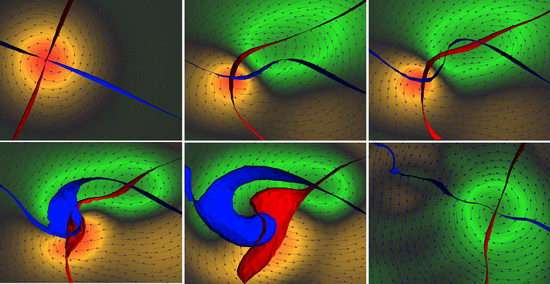Speed record for magnetic switching predicted

Scientists of the Research Centre Jülich, Germany, have found a fundamentally new magnetic switching method which achieves the fastest speed ever reported by applying an external magnetic field. The re-sults that are presented in a current article in the renowned scientific journal Physical Review Letters could introduce new possibilities for future data stor-age applications with ultimate speeds.
In disk-shaped small magnets of about a millionth of a meter the magnetization can naturally align to form vortex structures. These vortices are in many ways analogous to those which form in familiar situations such as water flowing down a drain or air spiralling in a hurricane. Magnetic vortices also have a centre called the "core", a region spanning about ten nanometres – the length of less than one hundred atoms.
The vortex core is a region where the magnetization points perpendicular to the sur-face, either "up" or "down". This naturally lends itself to applications in binary data storage, especially as the magnetization direction is very stable. This stability is caused by the strongest force present in magnets, the so-called exchange interac-tion. Only by exploiting this force does it become possible to flip the core without ap-plying very strong fields.
Using state-of-the-art computer simulations, the scientists in the group of Dr. Ric-cardo Hertel at the Institute of Solid State Research (IFF) in Jülich have demon-strated in collaboration with the Max Planck Institute in Stuttgart a way to flip the core with very short and relatively weak pulses. These pulses trigger internal processes in the magnet involving the force of the exchange interaction.
Owing to the strength of this force the processes are extremely fast: “The main result of the study is that the magnetic core can be flipped from "up" to "down" and vice versa by applying a mag-netic field pulse that can be as short as five picoseconds – nearly a hundred times faster than the fastest computer processor”, Hertel explains. “Within a few picosec-onds, the field pulse distorts the magnetic structure to the point where a vortex-antivortex pair is created in addition to the already existing vortex. This is followed by an annihilation process which leaves only one vortex behind, pointing "down" if the original vortex was "up". “
The details of these processes have been studied in previous papers where the Jülich researchers have shown that the exchange interaction is what drives the for-mation and annihilation of the vortices. “In a recent simulation study, we obtained a detailed description of the dynamics of vortex-antivortex annihilations - a previously unexplored, yet fundamental process in nanomagnetism” says Sebastian Gliga, Ph.D. student in Hertel’s group. Within five months, the group has shared these re-sults in three papers published in renowned journals such as Physical Review Letters and Nature. This reversal appears to be the most complex reversal mechanism pres-ently known in nanomagnetism.
Besides its extremely high speed, a remarkable aspect of this finding is that it unfolds automatically: The applied field only perturbs the magnetization, which then under-goes these complicated changes as it recovers equilibrium. “These findings represent a promising leap towards smaller length scales and shorter time scales in magnetic data storage applications”, affirms Prof. Claus M. Schneider, director at the IFF.
Source: Research Centre Jülich




















